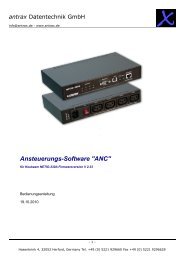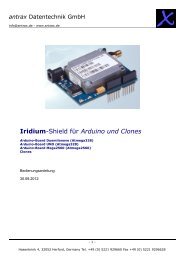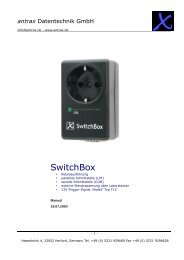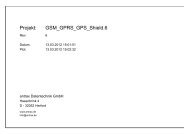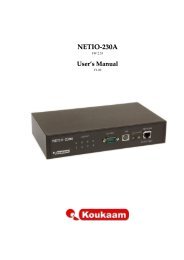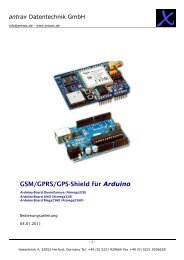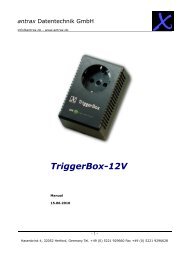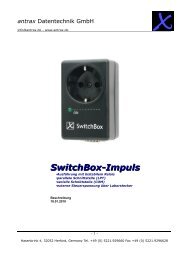Iridium Short Burst Data Service Developers ... - Discoverytelecom.eu
Iridium Short Burst Data Service Developers ... - Discoverytelecom.eu
Iridium Short Burst Data Service Developers ... - Discoverytelecom.eu
You also want an ePaper? Increase the reach of your titles
YUMPU automatically turns print PDFs into web optimized ePapers that Google loves.
<strong>Iridium</strong> Satellite LLC<br />
<strong>Short</strong> <strong>Burst</strong> <strong>Data</strong> <strong>Developers</strong> Guide V2.01<br />
4.1.4.2 Automatic SBD Ring Alert Notification& Retry Scheme<br />
When the GSS receives a MT-SBD message and the destination ISU is both configured to listen for SBD<br />
Ring Alerts, and it has successfully completed SBD Network Registration, the GSS sends a SBD Ring Alert<br />
to the ISU. If the ISU does not respond in approximately 13 seconds, a second SBD Ring Alert is sent. If the<br />
ISU does not respond to the second SBD Ring Alert, no further SBD Ring Alerts are sent until another new<br />
MT-SBD is qu<strong>eu</strong>ed for this specific ISU.<br />
If a subsequent MT-SBD message is received at the GSS for this ISU, the SBD Ring Alert process repeats<br />
itself. However, the GSS will not send a SBD Ring Alert if the subsequent MT-SBD is received within 10<br />
seconds of the receipt of the previous MT-SBD.<br />
Note that while the transfer of MO or MT SBD messages is via a reliable (duplex) protocol, SBD Ring Alerts<br />
are sent on a simplex channel. If the ISU is turned off or is blocked from seeing the satellite, then a<br />
SBD Ring Alert will not be received by the ISU and the GSS has no knowledge of whether an ISU<br />
eventually received a specific SBD Ring Alert or not.<br />
If an ISU, configured to receive SBD Ring Alerts, is not powered on and a MT-SBD message is qu<strong>eu</strong>ed at<br />
the GSS then, assuming the ISU is configured in the GSS for SBD Ring Alerts, the SBD Ring Alert will be<br />
sent out. However because the ISU is not powered on, the ISU will not receive the SBD Ring Alert. A<br />
subsequent power-on of the ISU will not cause the SBD Ring Alert to be delivered by the GSS. The GSS<br />
has no direct knowledge of the power on status of ISUs. In order for a Field Application to know whether<br />
there was a qu<strong>eu</strong>ed MT-SBD message at the GSS during the time that the ISU was powered off, the ISU<br />
can use either the +SBDSX command or it could send a MO-SBD message (+SBDI[X]) as specified in [3].<br />
If an ISU is on, and suitably configured, but does not have sufficient line of sight to the satellite due to<br />
terrestrial physical blockage the impact may be similar to the description of the powered off ISU just given.<br />
The behavior will depend on the amount of blockage. Applications designers should not rely on the use of<br />
+CSQ for determining whether an ISU can see a satellite at an instantaneous point in time on the 9601. To<br />
conserve power the +CSQ algorithm uses averaging over time.<br />
4.1.4.3 Retrieving MT-SBD Message from the GSS when notified by the SBD<br />
Ring Alert<br />
The GSS qu<strong>eu</strong>es the MT-SBD message for the ISU and sends SBD Ring Alert. The ISU receives the SBD<br />
Ring Alert and sends an unsolicited response to the Field Application. This response is either SBDRING in<br />
Verbose Mode or “2” in Numeric Mode. The Field Application interprets the response and initiates a SBD<br />
session with the +SBDIXA command. The “A” sufix indicates this is a response to the SBD Ring Alert.<br />
If the Field Application has a MO-SBD message to send, it moves the data into the transmit buffer prior to<br />
issuing the AT command. If the Field Application has nothing to send and just wants to retrieve the qu<strong>eu</strong>ed<br />
MT-SBD message, it clears the MO transmit buffer before initiating the session. The response codes from<br />
the +SBDIXA command indicate if there are additional MT-SBD messages waiting to be retrieved.<br />
Applications where the ISU will move significant distances fairly quickly (e.g. aircraft) and applications where<br />
the ISU will move through an environment where the ISU may not always have a good view of the sky (e.g.<br />
cities, mountainous regions) should use the Automatic SBD Network Registration capability if a high degree<br />
of reliability/low latency of delivered MT-SBD messages is desired.<br />
27<br />
<strong>Iridium</strong> Satellite LLC Proprietary & Confidential



